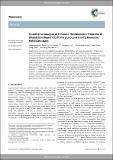Quantitative analyses of enhanced thermoelectric properties of modulation-doped PEDOT:PSS/undoped Si (001) nanoscale heterostructures
Author(s)
Lee, Dongwook; Sayed, Sayed Youssef; Lee, Sangyeop; Kuryak, Chris Adam; Zhou, Jiawei; Chen, Gang; Shao-Horn, Yang; ... Show more Show less
DownloadQuantitative analyses with SI.pdf (2.178Mb)
OPEN_ACCESS_POLICY
Open Access Policy
Creative Commons Attribution-Noncommercial-Share Alike
Terms of use
Metadata
Show full item recordAbstract
Poly(3,4-ethylenedioxythiophene) poly(styrenesulfonate) (PEDOT:PSS) has high electrical conductivity (∼10³ S cm⁻¹) but it exhibits a low Seebeck coefficient (<15 μV K⁻¹), resulting in a low power factor. Mixing PEDOT:PSS with nanostructured semiconductors can enhance the Seebeck coefficient and achieve an improved thermoelectric power factor. However, underlying mechanisms for those composite thermoelectric systems are scarcely understood so far. In this study, quantitative analyses on the electrical conductivity and Seebeck coefficient for the heterostructures of nanometer-thick PEDOT:PSS on single-crystal Si (001) on sapphire (SOS) are reported. The heterostructures have larger Seebeck coefficients up to 7.3 fold and power factors up to 17.5 fold relative to PEDOT:PSS. The electrical conductivity increased with decreasing combined thicknesses of PEDOT:PSS and Si, and the Seebeck coefficient increased with decreasing PEDOT:PSS thickness, which can be attributed to modulation doping caused by diffusion of holes from PEDOT:PSS into undoped Si. This hypothesis is supported by simulation per band alignment. The valence band offset between Si and PEDOT:PSS dominantly controls the electrical conductivity and Seebeck coefficient of the heterostructures. This study not only suggests mechanistic insights to increase the power factors of PEDOT:PSS-based composites but also opens the door for new strategies to enhance the thermoelectric efficiencies of heterostructured nanocomposite materials.
Date issued
2016-11Department
Massachusetts Institute of Technology. Department of Materials Science and Engineering; Massachusetts Institute of Technology. Department of Mechanical Engineering; Massachusetts Institute of Technology. Research Laboratory of ElectronicsJournal
Nanoscale
Publisher
Royal Society of Chemistry
Citation
Lee, Dongwook, et al. “Quantitative Analyses of Enhanced Thermoelectric Properties of Modulation-Doped PEDOT:PSS/undoped Si (001) Nanoscale Heterostructures.” Nanoscale 8, 47 (November 2016): 19754–19760 © 2016 The Royal Society of Chemistry
Version: Author's final manuscript
ISSN
2040-3364
2040-3372